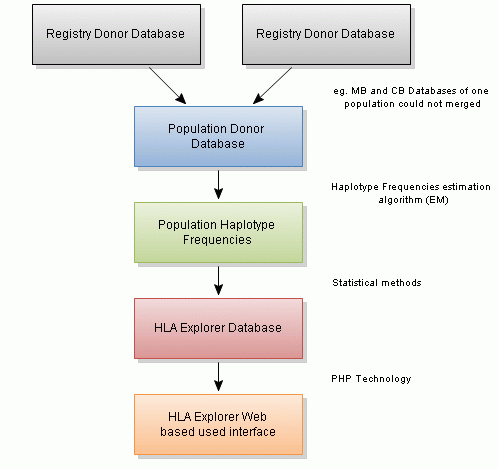Welcome to HLA Explorer
HLA Explorer is a new internet tool that helps physicians (transplant centers) and coordinators (stem cells donor registries) to examine Linkage Disequilibrium of HLA system in order to assist to find suitable unrelated stem cells donor.
If you are new user, you must register, it's for free. If you are registered user, please log in the upper right corner of the browser window.
Introduction
Transplantation of Haematopoietic Stem Cells (HSCT) is increasingly used treating technique for patients with severe disorders of hemopoiesis, and leukemia.
HLA match is still the decisive factor affecting the prognosis of a stem cell transplant therefore a very high degree of compatibility between the HLA-tissue types of donor and recipient is required. HSCT can be successfully applied only if donor and recipient are matched for a number of important genetic markers of the transplantation antigen system HLA.
The HLA system plays a key role in self-nonself recognition is broadly divided into highly polymorphic class I (HLA-A,-B, -C) and class II (HLA-DRB1, DQB1) loci. Mismatching within class I and class II HLA antigens between recipient and donor increases the incidence and severity of an alloreactive immune response when transplanting hematopoietic stem cells.
The chance of any patient to obtain fully matched unrelated stem cells donors is dependent on possibility to match with more than 12 million donors in the bone marrow donor registry. But, up to now many HLA typing results of unrelated donors are incomplete. In case two or more donors - who are potentially HLA identical - are available, coordinator can use “HLA Explorer” in order to choose donors for complementary genomic typing . The project “HLA Explorer” provides extensive information for haplotype frequencies.
Using of modern technologies such as HLA Explorer increase the chance to find a suitable donor in the shortest term possible.
Basic scheme

Access
HLA Explorer is the internet based information system that requires authorization of users. Everyone can register for free.
Data source
Current data are obtained from http://www.allelefrequencies.net and NMDP HLA database.
